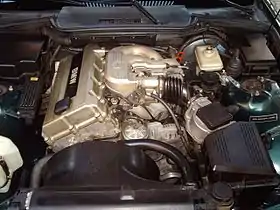BMW M42
The BMW M42 is a DOHC four-cylinder petrol engine which was produced from 1989-1996.[1] It is BMW's first mass-production DOHC engine and was produced alongside the BMW M40 SOHC four-cylinder engine as the higher performance engine.
| BMW M42 | |
|---|---|
 | |
| Overview | |
| Production | 1989–1996 |
| Layout | |
| Configuration | Inline-4 |
| Displacement | 1.8 L (110 cu in) |
| Block material | Cast iron |
| Head material | Aluminium |
| Valvetrain | DOHC |
| Combustion | |
| Fuel type | Petrol |
| Chronology | |
| Predecessor | BMW M40 |
| Successor | BMW M44 |
The M42 was replaced by the BMW M44, which was introduced in 1996.
Compared with the M40, the M42 features a DOHC valvetrain, a timing chain, hydraulic valve lifters and an increased 10.0:1 compression ratio.[2] Later versions of the M42 also feature a dual length intake manifold ("DISA").[2]
The M42 was used as the basis for the S42 racing engine, which powered the BMW 320i in the German Super Tourenwagen Cup.
Design
Following BMW's typical construction techniques at the time, the motor incorporates a cast-iron block and aluminium head. Weight-saving measures include aluminium chain cases, oil sump, motor mount arms, accessory mounts and a cartridge-style oil filter housing. Other features included a forged steel crankshaft and tubular stainless steel exhaust manifold instead of the more typical cast-iron items. BMW also fitted hydraulic motor mounts to decrease the inline four's inherent noise, vibration, and harshness compared to the smoother straight-six engines in production at that time.
When installed in the BMW E30, a two-piece oil pan with a removable front sump was fitted to the M42. In this two-piece arrangement, the upper oil pan casting incorporates the oil pump's supply passage, and is sealed to the crankcase oil filter housing with a paper gasket. This can cause problems, because thermal cycles and engine vibration tend to loosen the upper pan mounting bolts inside the motor.[3]
All versions featured a low-maintenance timing chain with a self-adjusting hydraulic chain tensioner and hydraulic valve tappets. The M42 uses the Bosch Motronic M1.7 engine management system, eliminating a distributor in favor of fully electronic ignition timing.[4] The ignition system also uses a coil-on-plug system. In markets that required emissions controls, the DME also incorporates an oxygen sensor and three-way catalytic converter.
Versions
| Engine | Displacement | Power | Torque | Year |
|---|---|---|---|---|
| M42B18 | 1,796 cc (109.6 cu in) | 103 kW (138 bhp) at 6,000 rpm | 175 N⋅m (129 lb⋅ft) at 4,500 rpm | 1989-1996 |
M42B18
The M42B18 has a displacement of 1,796 cc (109.6 cu in), which is achieved through a bore of 84 mm (3.3 in) and a stroke of 81 mm (3.2 in).[2] Versions equipped with a catalytic converter produce 100 kW (134 bhp) and 172 N⋅m (127 lb⋅ft).[1] and meet the Euro 2 emissions standard.
Applications:
S42B20
The racing version of the M42 engine is called the S42 and was used in BMW's 320 4-door touring car, participating in the German Super Tourenwagen Cup. Compared with the M42, the S42 has individual throttle bodies, the displacement increased to 1,999 cc (122.0 cu in), two fuel injectors per cylinder, an increased compression ratio and a different cylinder head. The valve cover and airbox were made from carbon fiber and the lubrication system used a dry sump.
In 1995, the initial version of the S42 engine produced 224 kW (300 bhp), increasing to 235 kW (315 bhp) for the final version in 1997.
Timing system revisions
The earliest versions of the M42 developed problems with the camshaft chain drive. The hydraulic tensioner,[5] chain guides, idler wheel and rear lower chain case were updated to resolve wear problems experienced in the early versions of the M42.[6]
In September 1993, BMW redesigned the M42's timing chain guide rails, replacing the occasionally troublesome lower idler gear with a curved nylon guide rail. The idler gear's retaining bolt could break away from the timing case, often taking a chunk of alloy timing case with it.
Recalls
Early models of the M42 experienced failures of a profile gasket sealing the lower cam chain case to the underside of the cylinder head.[7] This gasket seals the primary coolant passage within the timing chain case. A significant failure would thus discharge pressurized steam and hot coolant into the timing chain case. In many cases this coolant rapidly contaminates the motor oil in the sump, causing main bearing failure. BMW updated the profile gasket material and instituted a program to repair motors under warranty. In extreme cases, the aluminum mating surfaces in the head and chain case would corrode.[8]
See also
References
- "Information on M42 engines". www.bmwheaven.com. Retrieved 18 February 2017.
- "BMW E30 specifications". www.e30world.com. Archived from the original on 2013-02-24.
- "Engine failure due to pan gasket shift/bolt loss". www.m42club.com. Archived from the original on 27 November 2010.
- "BMW M42 and M44 Four Cylinder Engines". www.unixnerd.demon.co.uk. Retrieved 18 February 2017.
- "M42 Chain Tensioner Replacement". www.e30zone.net. Retrieved 20 February 2017.
- "318is (M42) Timing chain tensioner". www.bimmerforums.com. Retrieved 20 February 2017.
- "318i M42 Profile Gasket Problem". www.unofficialbmw.com. Retrieved 18 February 2017.
- "BMW M42 318i - Timing Case Profile Gasket". www.timthurber.com. Retrieved 18 February 2017.
| Wikimedia Commons has media related to BMW M42 engine. |
